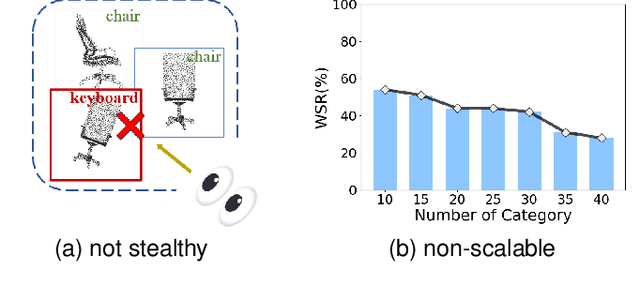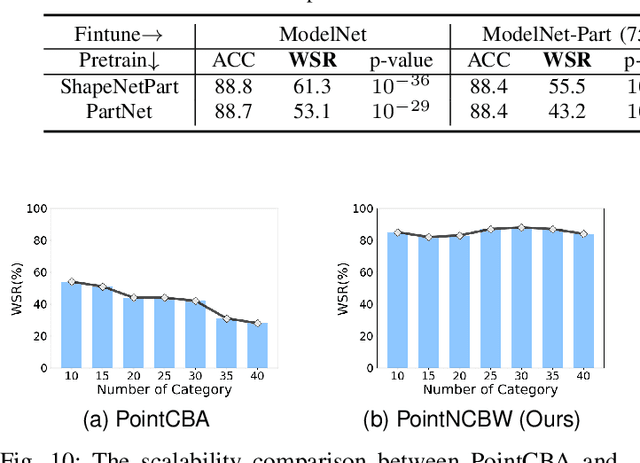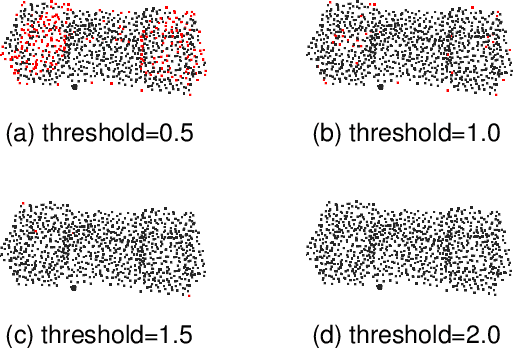Zhan Qin
ControlNET: A Firewall for RAG-based LLM System
Apr 13, 2025Abstract:Retrieval-Augmented Generation (RAG) has significantly enhanced the factual accuracy and domain adaptability of Large Language Models (LLMs). This advancement has enabled their widespread deployment across sensitive domains such as healthcare, finance, and enterprise applications. RAG mitigates hallucinations by integrating external knowledge, yet introduces privacy risk and security risk, notably data breaching risk and data poisoning risk. While recent studies have explored prompt injection and poisoning attacks, there remains a significant gap in comprehensive research on controlling inbound and outbound query flows to mitigate these threats. In this paper, we propose an AI firewall, ControlNET, designed to safeguard RAG-based LLM systems from these vulnerabilities. ControlNET controls query flows by leveraging activation shift phenomena to detect adversarial queries and mitigate their impact through semantic divergence. We conduct comprehensive experiments on four different benchmark datasets including Msmarco, HotpotQA, FinQA, and MedicalSys using state-of-the-art open source LLMs (Llama3, Vicuna, and Mistral). Our results demonstrate that ControlNET achieves over 0.909 AUROC in detecting and mitigating security threats while preserving system harmlessness. Overall, ControlNET offers an effective, robust, harmless defense mechanism, marking a significant advancement toward the secure deployment of RAG-based LLM systems.
On Benchmarking Code LLMs for Android Malware Analysis
Apr 01, 2025Abstract:Large Language Models (LLMs) have demonstrated strong capabilities in various code intelligence tasks. However, their effectiveness for Android malware analysis remains underexplored. Decompiled Android code poses unique challenges for analysis, primarily due to its large volume of functions and the frequent absence of meaningful function names. This paper presents Cama, a benchmarking framework designed to systematically evaluate the effectiveness of Code LLMs in Android malware analysis tasks. Cama specifies structured model outputs (comprising function summaries, refined function names, and maliciousness scores) to support key malware analysis tasks, including malicious function identification and malware purpose summarization. Built on these, it integrates three domain-specific evaluation metrics, consistency, fidelity, and semantic relevance, enabling rigorous stability and effectiveness assessment and cross-model comparison. We construct a benchmark dataset consisting of 118 Android malware samples, encompassing over 7.5 million distinct functions, and use Cama to evaluate four popular open-source models. Our experiments provide insights into how Code LLMs interpret decompiled code and quantify the sensitivity to function renaming, highlighting both the potential and current limitations of Code LLMs in malware analysis tasks.
Imperceptible but Forgeable: Practical Invisible Watermark Forgery via Diffusion Models
Mar 28, 2025Abstract:Invisible watermarking is critical for content provenance and accountability in Generative AI. Although commercial companies have increasingly committed to using watermarks, the robustness of existing watermarking schemes against forgery attacks is understudied. This paper proposes DiffForge, the first watermark forgery framework capable of forging imperceptible watermarks under a no-box setting. We estimate the watermark distribution using an unconditional diffusion model and introduce shallow inversion to inject the watermark into a non-watermarked image seamlessly. This approach facilitates watermark injection while preserving image quality by adaptively selecting the depth of inversion steps, leveraging our key insight that watermarks degrade with added noise during the early diffusion phases. Comprehensive evaluations show that DiffForge deceives open-source watermark detectors with a 96.38% success rate and misleads a commercial watermark system with over 97% success rate, achieving high confidence.1 This work reveals fundamental security limitations in current watermarking paradigms.
Towards Label-Only Membership Inference Attack against Pre-trained Large Language Models
Feb 26, 2025Abstract:Membership Inference Attacks (MIAs) aim to predict whether a data sample belongs to the model's training set or not. Although prior research has extensively explored MIAs in Large Language Models (LLMs), they typically require accessing to complete output logits (\ie, \textit{logits-based attacks}), which are usually not available in practice. In this paper, we study the vulnerability of pre-trained LLMs to MIAs in the \textit{label-only setting}, where the adversary can only access generated tokens (text). We first reveal that existing label-only MIAs have minor effects in attacking pre-trained LLMs, although they are highly effective in inferring fine-tuning datasets used for personalized LLMs. We find that their failure stems from two main reasons, including better generalization and overly coarse perturbation. Specifically, due to the extensive pre-training corpora and exposing each sample only a few times, LLMs exhibit minimal robustness differences between members and non-members. This makes token-level perturbations too coarse to capture such differences. To alleviate these problems, we propose \textbf{PETAL}: a label-only membership inference attack based on \textbf{PE}r-\textbf{T}oken sem\textbf{A}ntic simi\textbf{L}arity. Specifically, PETAL leverages token-level semantic similarity to approximate output probabilities and subsequently calculate the perplexity. It finally exposes membership based on the common assumption that members are `better' memorized and have smaller perplexity. We conduct extensive experiments on the WikiMIA benchmark and the more challenging MIMIR benchmark. Empirically, our PETAL performs better than the extensions of existing label-only attacks against personalized LLMs and even on par with other advanced logit-based attacks across all metrics on five prevalent open-source LLMs.
REFINE: Inversion-Free Backdoor Defense via Model Reprogramming
Feb 22, 2025Abstract:Backdoor attacks on deep neural networks (DNNs) have emerged as a significant security threat, allowing adversaries to implant hidden malicious behaviors during the model training phase. Pre-processing-based defense, which is one of the most important defense paradigms, typically focuses on input transformations or backdoor trigger inversion (BTI) to deactivate or eliminate embedded backdoor triggers during the inference process. However, these methods suffer from inherent limitations: transformation-based defenses often fail to balance model utility and defense performance, while BTI-based defenses struggle to accurately reconstruct trigger patterns without prior knowledge. In this paper, we propose REFINE, an inversion-free backdoor defense method based on model reprogramming. REFINE consists of two key components: \textbf{(1)} an input transformation module that disrupts both benign and backdoor patterns, generating new benign features; and \textbf{(2)} an output remapping module that redefines the model's output domain to guide the input transformations effectively. By further integrating supervised contrastive loss, REFINE enhances the defense capabilities while maintaining model utility. Extensive experiments on various benchmark datasets demonstrate the effectiveness of our REFINE and its resistance to potential adaptive attacks.
Boosting Illuminant Estimation in Deep Color Constancy through Enhancing Brightness Robustness
Feb 18, 2025Abstract:Color constancy estimates illuminant chromaticity to correct color-biased images. Recently, Deep Neural Network-driven Color Constancy (DNNCC) models have made substantial advancements. Nevertheless, the potential risks in DNNCC due to the vulnerability of deep neural networks have not yet been explored. In this paper, we conduct the first investigation into the impact of a key factor in color constancy-brightness-on DNNCC from a robustness perspective. Our evaluation reveals that several mainstream DNNCC models exhibit high sensitivity to brightness despite their focus on chromaticity estimation. This sheds light on a potential limitation of existing DNNCC models: their sensitivity to brightness may hinder performance given the widespread brightness variations in real-world datasets. From the insights of our analysis, we propose a simple yet effective brightness robustness enhancement strategy for DNNCC models, termed BRE. The core of BRE is built upon the adaptive step-size adversarial brightness augmentation technique, which identifies high-risk brightness variation and generates augmented images via explicit brightness adjustment. Subsequently, BRE develops a brightness-robustness-aware model optimization strategy that integrates adversarial brightness training and brightness contrastive loss, significantly bolstering the brightness robustness of DNNCC models. BRE is hyperparameter-free and can be integrated into existing DNNCC models, without incurring additional overhead during the testing phase. Experiments on two public color constancy datasets-ColorChecker and Cube+-demonstrate that the proposed BRE consistently enhances the illuminant estimation performance of existing DNNCC models, reducing the estimation error by an average of 5.04% across six mainstream DNNCC models, underscoring the critical role of enhancing brightness robustness in these models.
DELMAN: Dynamic Defense Against Large Language Model Jailbreaking with Model Editing
Feb 17, 2025Abstract:Large Language Models (LLMs) are widely applied in decision making, but their deployment is threatened by jailbreak attacks, where adversarial users manipulate model behavior to bypass safety measures. Existing defense mechanisms, such as safety fine-tuning and model editing, either require extensive parameter modifications or lack precision, leading to performance degradation on general tasks, which is unsuitable to post-deployment safety alignment. To address these challenges, we propose DELMAN (Dynamic Editing for LLMs JAilbreak DefeNse), a novel approach leveraging direct model editing for precise, dynamic protection against jailbreak attacks. DELMAN directly updates a minimal set of relevant parameters to neutralize harmful behaviors while preserving the model's utility. To avoid triggering a safe response in benign context, we incorporate KL-divergence regularization to ensure the updated model remains consistent with the original model when processing benign queries. Experimental results demonstrate that DELMAN outperforms baseline methods in mitigating jailbreak attacks while preserving the model's utility, and adapts seamlessly to new attack instances, providing a practical and efficient solution for post-deployment model protection.
FIT-Print: Towards False-claim-resistant Model Ownership Verification via Targeted Fingerprint
Jan 26, 2025Abstract:Model fingerprinting is a widely adopted approach to safeguard the intellectual property rights of open-source models by preventing their unauthorized reuse. It is promising and convenient since it does not necessitate modifying the protected model. In this paper, we revisit existing fingerprinting methods and reveal that they are vulnerable to false claim attacks where adversaries falsely assert ownership of any third-party model. We demonstrate that this vulnerability mostly stems from their untargeted nature, where they generally compare the outputs of given samples on different models instead of the similarities to specific references. Motivated by these findings, we propose a targeted fingerprinting paradigm (i.e., FIT-Print) to counteract false claim attacks. Specifically, FIT-Print transforms the fingerprint into a targeted signature via optimization. Building on the principles of FIT-Print, we develop bit-wise and list-wise black-box model fingerprinting methods, i.e., FIT-ModelDiff and FIT-LIME, which exploit the distance between model outputs and the feature attribution of specific samples as the fingerprint, respectively. Extensive experiments on benchmark models and datasets verify the effectiveness, conferrability, and resistance to false claim attacks of our FIT-Print.
Mitigating Privacy Risks in LLM Embeddings from Embedding Inversion
Nov 06, 2024



Abstract:Embeddings have become a cornerstone in the functionality of large language models (LLMs) due to their ability to transform text data into rich, dense numerical representations that capture semantic and syntactic properties. These embedding vector databases serve as the long-term memory of LLMs, enabling efficient handling of a wide range of natural language processing tasks. However, the surge in popularity of embedding vector databases in LLMs has been accompanied by significant concerns about privacy leakage. Embedding vector databases are particularly vulnerable to embedding inversion attacks, where adversaries can exploit the embeddings to reverse-engineer and extract sensitive information from the original text data. Existing defense mechanisms have shown limitations, often struggling to balance security with the performance of downstream tasks. To address these challenges, we introduce Eguard, a novel defense mechanism designed to mitigate embedding inversion attacks. Eguard employs a transformer-based projection network and text mutual information optimization to safeguard embeddings while preserving the utility of LLMs. Our approach significantly reduces privacy risks, protecting over 95% of tokens from inversion while maintaining high performance across downstream tasks consistent with original embeddings.
PointNCBW: Towards Dataset Ownership Verification for Point Clouds via Negative Clean-label Backdoor Watermark
Aug 10, 2024



Abstract:Recently, point clouds have been widely used in computer vision, whereas their collection is time-consuming and expensive. As such, point cloud datasets are the valuable intellectual property of their owners and deserve protection. To detect and prevent unauthorized use of these datasets, especially for commercial or open-sourced ones that cannot be sold again or used commercially without permission, we intend to identify whether a suspicious third-party model is trained on our protected dataset under the black-box setting. We achieve this goal by designing a scalable clean-label backdoor-based dataset watermark for point clouds that ensures both effectiveness and stealthiness. Unlike existing clean-label watermark schemes, which are susceptible to the number of categories, our method could watermark samples from all classes instead of only from the target one. Accordingly, it can still preserve high effectiveness even on large-scale datasets with many classes. Specifically, we perturb selected point clouds with non-target categories in both shape-wise and point-wise manners before inserting trigger patterns without changing their labels. The features of perturbed samples are similar to those of benign samples from the target class. As such, models trained on the watermarked dataset will have a distinctive yet stealthy backdoor behavior, i.e., misclassifying samples from the target class whenever triggers appear, since the trained DNNs will treat the inserted trigger pattern as a signal to deny predicting the target label. We also design a hypothesis-test-guided dataset ownership verification based on the proposed watermark. Extensive experiments on benchmark datasets are conducted, verifying the effectiveness of our method and its resistance to potential removal methods.
 Add to Chrome
Add to Chrome Add to Firefox
Add to Firefox Add to Edge
Add to Edge